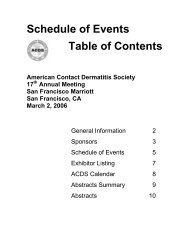American Contact Dermatitis Society 21 Annual Meeting
American Contact Dermatitis Society 21 Annual Meeting
American Contact Dermatitis Society 21 Annual Meeting
Create successful ePaper yourself
Turn your PDF publications into a flip-book with our unique Google optimized e-Paper software.
Results<br />
Both isoeugenol and DNCB encapsulated in 200-300 nm ethosomes gave significantly increased<br />
sensitization response in the modified local lymph node assay compared to the model allergens in<br />
solution without ethosomes.<br />
Conclusion<br />
For the first time it is shown in animal experiments that encapsulation of contact allergens in vesicular<br />
carrier systems may enhance the sensitization response. The clinical implications of this finding are<br />
unclear.<br />
Prevalence of Patch Test Reactivity to Metals in a Cohort of Veterans Exposed To<br />
Shrapnel Fragments During Iraqi Conflicts<br />
Marianna Shvartsbeyn, 1 Papapit Tuchinda, 2 Katherine S. Squibb, 3,4 Melissa A. McDiarmid, 3,5 and<br />
Anthony A. Gaspari 6<br />
1 Department of Pathology, New York University, New York, USA<br />
2<br />
Department of Dermatology, Faculty of Medicine, Siriraj Hospital, Mahidol University, Bangkok, Thailand<br />
3<br />
Veterans Affairs Medical Center, Baltimore, Maryland, USA<br />
4<br />
Department of Epidemiology and Preventive Medicine, University of Maryland School of Medicine,<br />
Baltimore, Maryland, USA<br />
5<br />
Department of Medicine, University of Maryland School of Medicine, Baltimore, Maryland, USA<br />
6<br />
Department of Dermatology, University of Maryland School of Medicine, Baltimore, Maryland, USA<br />
U.S. Gulf War I veterans participating in the Baltimore VA Depleted Uranium Program Follow-Up<br />
surveillance in Spring 2009 were screened for skin reactivity to metals utilizing patch testing (PT). Forty<br />
veterans were tested with the extended metal series and soluble uranyl nitrate (0.25%, 2.5%, and 25%).<br />
Seventeen of them were also tested for sensitivity to nickel, cobalt and chromium. Elevated urine uranium<br />
was found in some veterans with retained DU fragments, yet none of them had significant PT reactions.<br />
The highest prevalence of reactivity was observed with zinc, gold and manganese (25%, 15% and 12.5%,<br />
respectively). Both zinc and manganese were found in metal fragments extracted from combat wounds.<br />
The prevalence of PT reactivity to these metals in the general population is not well known. Prolonged<br />
exposure to metals released from embedded fragments may induce immunologic reactivity in some<br />
individuals and requires further study.<br />
These studies were approved by the VA and University of Maryland IRBs.<br />
Case Report: Patch Testing a Patient with Eosinophilic Gastroenteritis Resulting<br />
in Dramatic Improvement<br />
David Smart, MS (1), and Douglas L Powell, MD (2)<br />
1- Medical College of Wisconsin, Milwaukee, Wisconsin<br />
2- University of Utah, Department of Dermatology, Salt Lake City, Utah<br />
Eosinophilic gastroenteritis is a member of a heterogenous group of eosinophilic gastroenteropathies that<br />
have in common an eosinophilic inflammation of the gut. These conditions commonly start in childhood<br />
and can present with many manifestations including: nausea, dysphagia, abdominal pain, vomiting,<br />
diarrhea, bowel obstruction, weight loss, or failure to thrive. A large portion of these cases are felt to be<br />
caused by allergies to food both IgE mediated allergies as well as delayed-type allergies. Prick tests and<br />
patch tests (usually described as atopic patch testing ) have been utilized to determine the food allergies.<br />
All of the reports regarding these cases and studies are found in the allergy/immunology or<br />
gastroenterology literature.<br />
<strong>21</strong>






